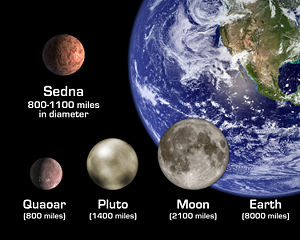 Image via WikipediaHere's a fun fact for you: I am approximately 56 attoParsecs tall. Contrary to what Han Solo would have you believe, a parsec is a unit of distance. One Parsec is roughly 3.26 light years, or 3.085 x 1016 meters. The prefix atto describes 10-18 Parsecs. Carry the math and you get 3.085 x 10-2 meters, or 3.085 centimeters. Thus, at 5'8" I am roughly 56 attoParsecs tall.
Image via WikipediaHere's a fun fact for you: I am approximately 56 attoParsecs tall. Contrary to what Han Solo would have you believe, a parsec is a unit of distance. One Parsec is roughly 3.26 light years, or 3.085 x 1016 meters. The prefix atto describes 10-18 Parsecs. Carry the math and you get 3.085 x 10-2 meters, or 3.085 centimeters. Thus, at 5'8" I am roughly 56 attoParsecs tall.There are lots of oddball units of measure like the attoParsec that have fallen into regular scientific usage, though many of them have more than mere amusement behind their origins.
Take a barn, which is equal to 10 square femtometers (10-28 m2). That's the cross-sectional area of a typical uranium nucleus, which is a scale of area that comes up a lot in nuclear magnetic resonance research. Describing the nuclear cross-section of uranium as "big as a barn" is ironic, but the unit has practical applications. Scientists don't enjoy using scientific notation much more than the next geek, so they create units of measure that let them use conventional numeric terms when describing observed experimental values.
Besides, it's much more fun to talk about barns than it is square femtometers.
Not all unconventional units of measure are there to accommodate extremely small scales. Quite the contrary. The Galactic Year (GY), for example, is roughly equal to 250 million years -- the length of time it takes for the Earth to complete one revolution around the Milky Way. Earth is roughly 20 GY old, and the Cretaceous-Tertiary Extinction Event that wiped out the dinosaurs occurred roughly 0.4 Galactic Years ago.
So what's the most out-of-scale unit of measure in use today? How about one that can describe the entire lifetime output of our sun without sneaking up on double digits. It's the same unit of measure explicitly designed to describe supernovas.
What unit of measure was created specifically to describe the energy output of supernovas?



